Artifact In The Spotlight 2020
In 2020, the museum's collection staff highlighted the following artifacts from the museum's collection.
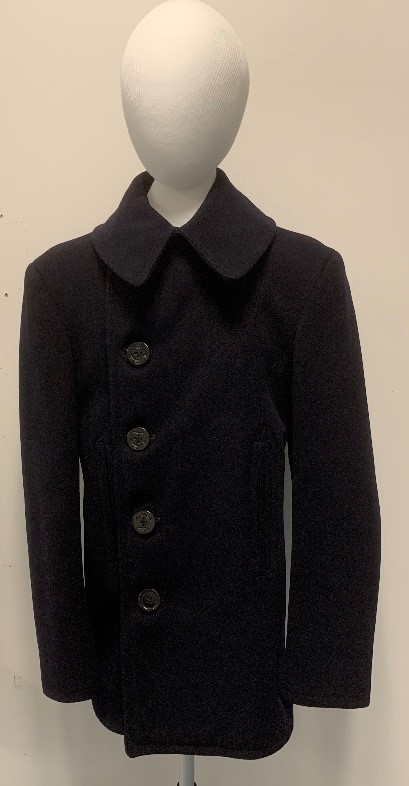
January 2020
Electrician Mate 3rd class John Fenoglio Peacoat
John Fenoglio was born in March 29,1920, in Cherry, Illinois to an Italian immigrant family. His father worked in the coal mine industry. According to his draft document, dated July 1941, John was 21 years old, weighed 122 pounds, had a sallow complexion, gray eyes, brown hair and was about 5'8" tall.
In the United States Navy John was trained as an Electrician Mate 3rd class and he served on both the USS Ericsson (DD-440) in 1945 and the USS Los Angeles (CA-135) from 1945-1946. John's WWII-era uniform, peacoat included, was manufactured by Naval Clothing Factory.
After World War II, John owned and operated Fenoglio TV and Appliance in Marseille, Illinois where the store was open from 1947-1989.
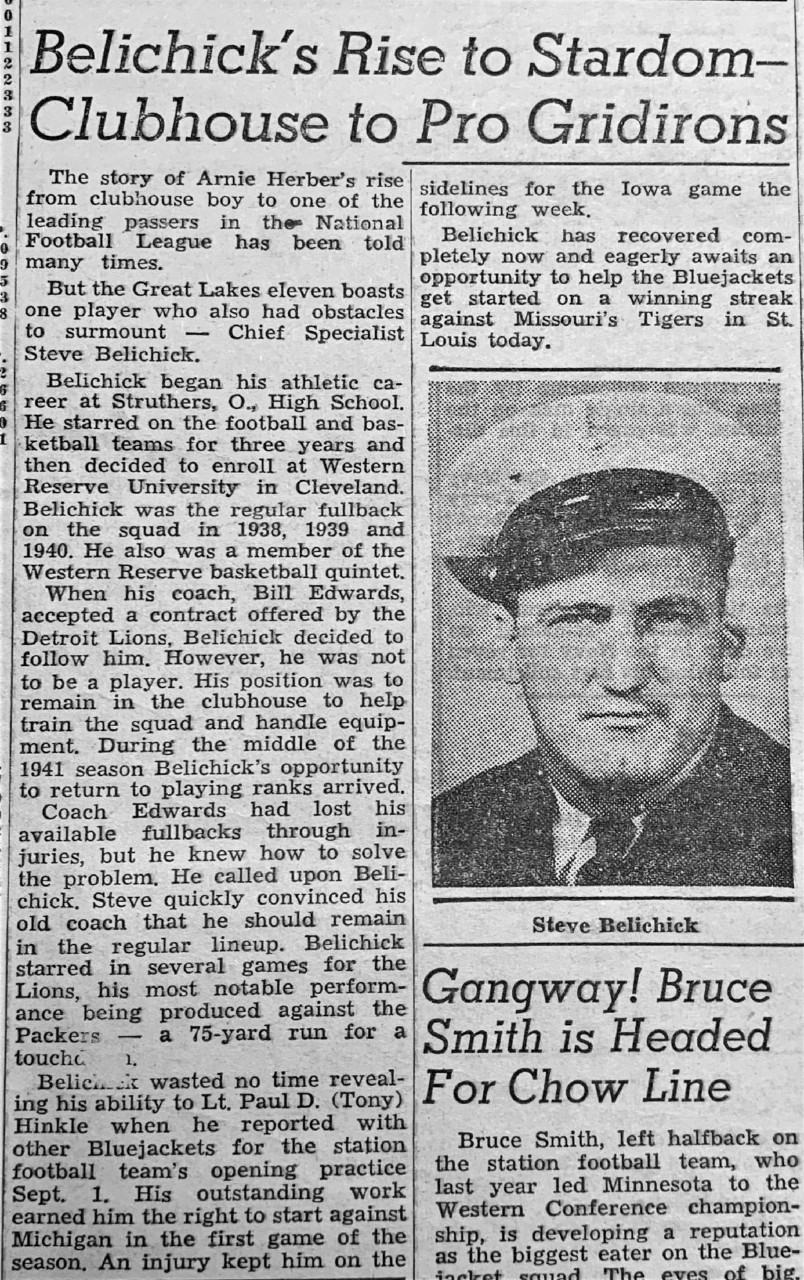
February 2020
Newspaper Article about Chief Specialist Steve Belichick
The sports teams at Great Lakes have a long history peppered with athletes who went on to accomplish amazing feats on and off the field. One such sailor was Chief Specialist Steve Belichick.
Belichick joined the Navy in 1942 and served in both Europe and the Pacific Theater during World War II. He later went on to spend over thirty years as a scout for the United State Naval Academy and is the father of current New England Patriots coach, Bill Belichick. Check out this article about Chief Specialist Steve Belichick's football feats from a 1942 edition of The Great Lakes Bulletin.
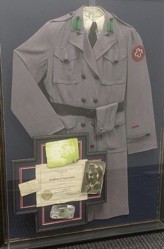
March 2020
Grace McNally WWII Red Cross Artifacts
During World War II, the American Red Cross played a critical role in the wartime effort both on the front and home front. By 1945, 7.5 million Red Cross volunteers assisted the organization’s 39,000 paid staff in providing service to the military. Throughout World War II, the organization served 16 million military personnel.
The Midwest’s Ninth Naval District had Red Cross staff members assigned to it to assist the installation with numerous medical functions on base. This shadowbox features Grace McNally’s World War II Red Cross Uniform, identification card, and accompanying photographs and certificate. In her early twenties, McNally volunteered for the Red Cross and served throughout the war. During her time at the Red Cross, she served in the Motor Corps and drove ambulances. Her sister, Margaret McNally, also volunteered for the Red Cross.
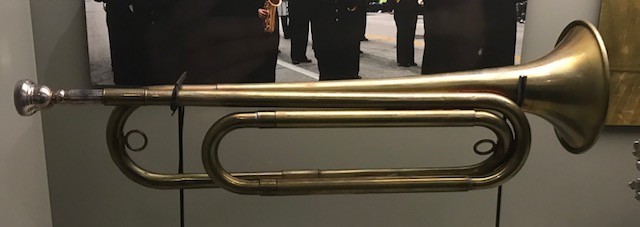
April 2020
1940s Bugle
A regulation U.S. Navy bugle is made of brass and is in the Key of "G." A bugle has five key parts, which include the mouthpiece, the tube, the bell tube, the bell, and the tuning slide.
The official "Manual for Buglers," originally dating from 1919, is one in a series of Navy Training Courses prepared by the Bureau of Naval Personnel. Designed for a quick self-study, there are six chapters, The Bugler, Sounding the Bugle, Reading Music, Starting your Practice, Bugle Practice, and The Calls.
The bugle is used as a warning call for the ship. According to the manual, there are over 100 different calls including two of the most recognizable, Evening Colors and Taps. The calls are broken up into three main categories: Routine, Emergency, and Routine and Emergency. An example of a "Routine" call would be Attention to Orders, an "Emergency call" would be Man Overboard or Torpedo Defense Quarters. An example of a "Routine and Emergency Call" would be Watertight Doors, which would be "sounded as a signal to secure the ship below the water line for the night during maneuvers or fog."
Though the bugle in the NMAS colelction dates from the 1940s, the same design was used by buglers at Great Lakes as early as 1911. Today, the bugle is still used and its sound is distinctly recognizable.
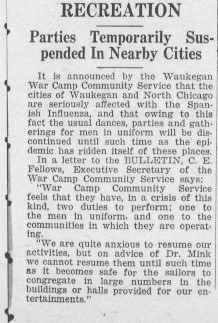
May 2020
Newspaper Article about the Spanish Flu Pandemic
While the preventative measures for COVID-19 may at times feel restrictive and stifling, "social distancing" is not a new phenomenon. It was also employed during the 1918 influenza pandemic, one of the deadliest pandemics in world history. The death toll for that pandemic is estimated between 17 and 50 million people, though the number could be much, much higher.
The 1918 pandemic targeted the very young, meaning a naval boot camp full of eighteen year olds, like Naval Station Great Lakes, sadly offered the perfect home for the virus. As evidenced in this Great Lakes Bulletin article from October 15, 1918, events in nearby North Chicago and Waukegan were canceled in the hopes that the disease would slow its spread if sailors and other infected persons didn't leave the base. It is thought that the 1918 pandemic spread as far and quickly as it did because not enough preventative measures were taken early on.
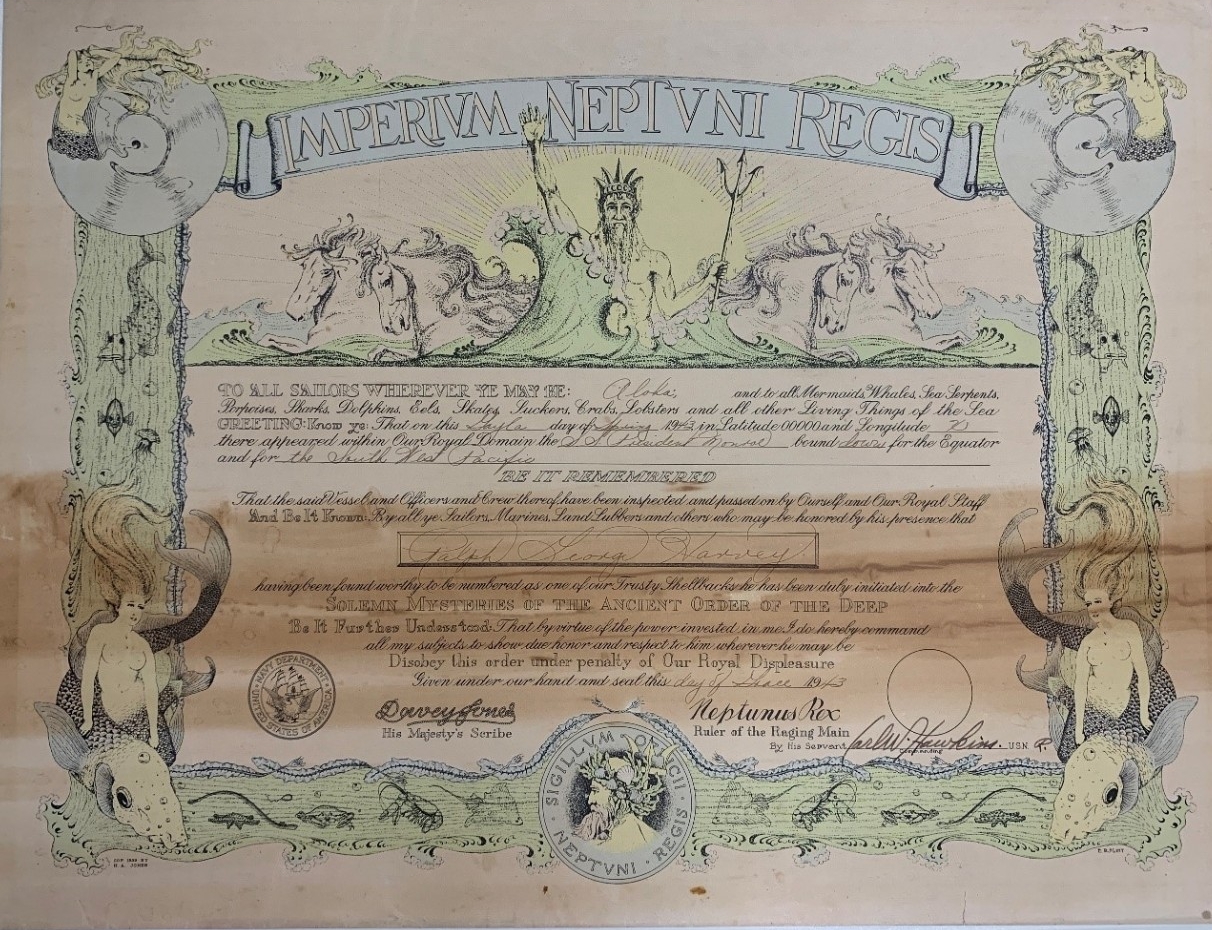
June 2020
Equator Crossing Certificate
This Equater Crossing Certificate was earned by Ralph George Harvey in 1943. Crossing the equator while at sea is a noteworthy achievement for any sailor. Ceremonies were held to initiate the new sailors into the ranks of “shellbacks,” otherwise known as sailors who have already crossed the equator. The ceremonies often featured King Neptune, god of the seas. All Sailors were presented with a certificate to mark the achievement. As you can see, these certificates were more than official records; they are also works of art.
July 2020
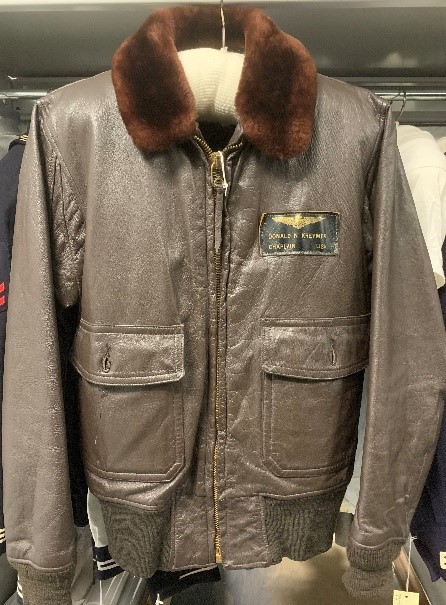
Type G-1 Flight Jacket
Donald Kreymer first joined the United States Navy on 1 June 1943 at the rank of Ensign. His draft card lists him as being 21 years old, 135 lbs., 5’8” tall, with light complexion, blue eyes, and brown hair. During World War II he did his carrier qualifications at Naval Air Station Glenview, and served on the USS Gambier Bay (CVE-73) during his service.
Called again to help his country, Kreymer served with the United States Navy during the Vietnam War. From 1963-1969, he served as an active duty Chaplain. To the right is Chaplain Kreymer's Type G-1 flight jacket, which he wore during his service in Vietnam.
Extra Naval history trivia: Star Sportswear Mfg. Co. out of Massachusetts produced this Type G-1.
August 2020
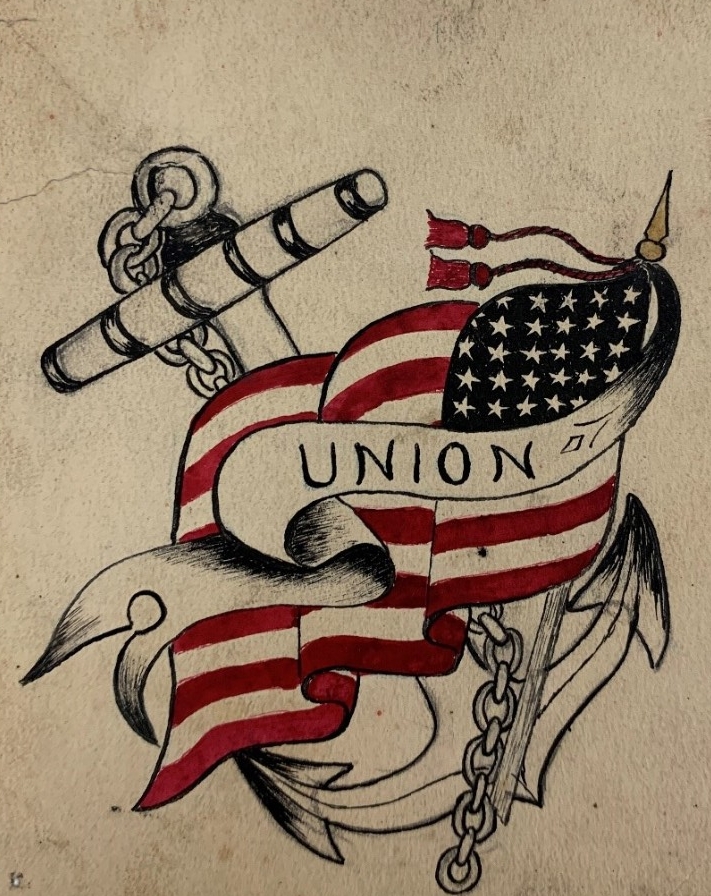
Tattoo Flash Art
Sailors’ love of tattoos stretches back hundreds of years, to when British Royal Navy officer Captain James Cook first explored the Polynesian islands in the eighteenth century. American Sailors embraced tattoos. One example from the National American of the American Sailor’s artifact collection that demonstrates this love is the tattoo art of Coridon Laverne Wheeler, a United States Navy Sailor who drew this image around the turn of the twentieth century. Born in 1874, Wheeler served aboard the USS Chicago, which later became USS Chicago (CA-14). "Flash art" are pre-made tattoo design sheets from which Sailors would pick ready-made tattoos from tattoo shop display books or walls, a tradition still followed today.
Anchors and American flags were, and still are, popular designs for Sailors, especially after the USS Maine (ACR-1) sank in Havana Harbor on 15 February 1898, killing three-quarters of its crew. The Maine’s explosion served as a catalyst for the United States' involvement in the Spanish-American War. Following its explosion, American Sailors tattooed memorials of the USS Maine as a sign of patriotism and to honor their perished shipmates.
In today's modern Navy, Sailors continue to get tattoos of flags, memorials, or other patriotic symbols tattooed as a way to honor those that came before and as a bond to the heritage of enlisted Sailors. Wheeler’s sketchbook, along with his tattoo kit, are part of National Museum of the American Sailor’s permanent collection.
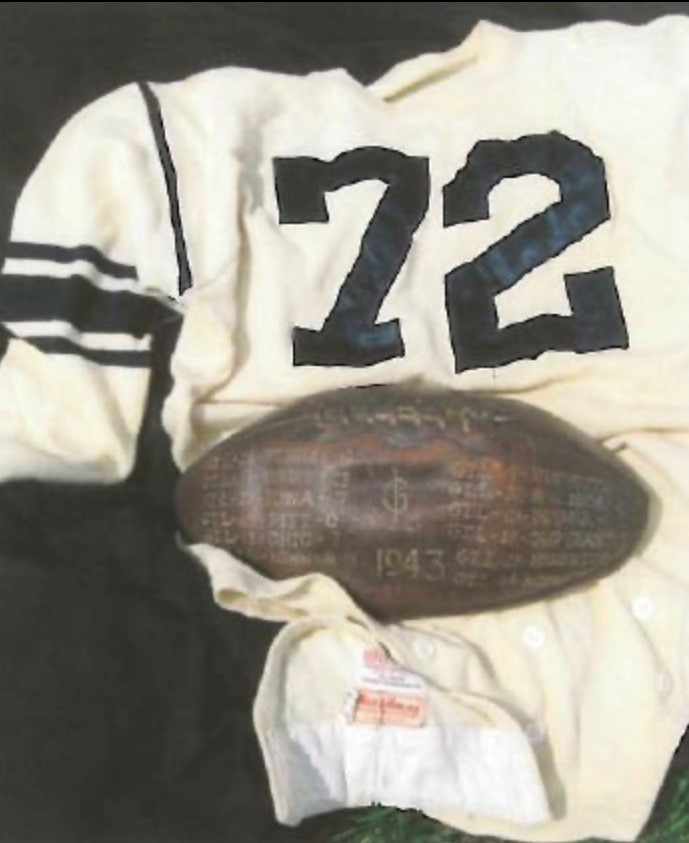
September 2020
WWII Bluejacket Jersey and Football
September is traditionally kickoff month for the National Football League, which makes this month’s Artifact Spotlight a real touchdown. Did you know that Naval Station Great Lakes was home to a football team called the Great Lakes Bluejackets? Football like, many other team sports played in the United States Navy, served multiple functions. Sports helped build comradery and offered a way to boost morale; as well as keeping Sailors physically fit and ready for duty. The Great Lakes Bluejackets are a good example of the importance and function that sports teams served in the day-to-day life of the enlisted Sailor here at Great Lakes and in the United States Navy.
Although the Bluejackets originally formed during World War I, this artifact comes from the World War II era. Bluejacket Emil Drvaric wore jersey #72 during his football career at Great Lakes. Born in Milwaukee, Wisconsin, Drvaric attended Milwaukee’s Lincoln High School before attending the University of Wisconsin in 1942. While there, he played guard on the freshman football team. After his first year, Emil was drafted into the United States Navy and underwent bootcamp at Great Lakes Naval Training Station. Along with his Bluejackets’ jersey from the 1943 football season, this collection also contains a football on which, written in gold, are all of the 1943 season’s games.
After leaving Great Lakes, Emil Drvaric continued to play football for the United States Navy; from 1944-1945 he was on the Navy All-Star team at Pearl Harbor. After his discharge from the Navy on 1 January 1945, he went on to play for Harvard University from 1946-1948. Items such as Drvaric’s tell a unique and personalized story about football and the United States Navy.
October 2020
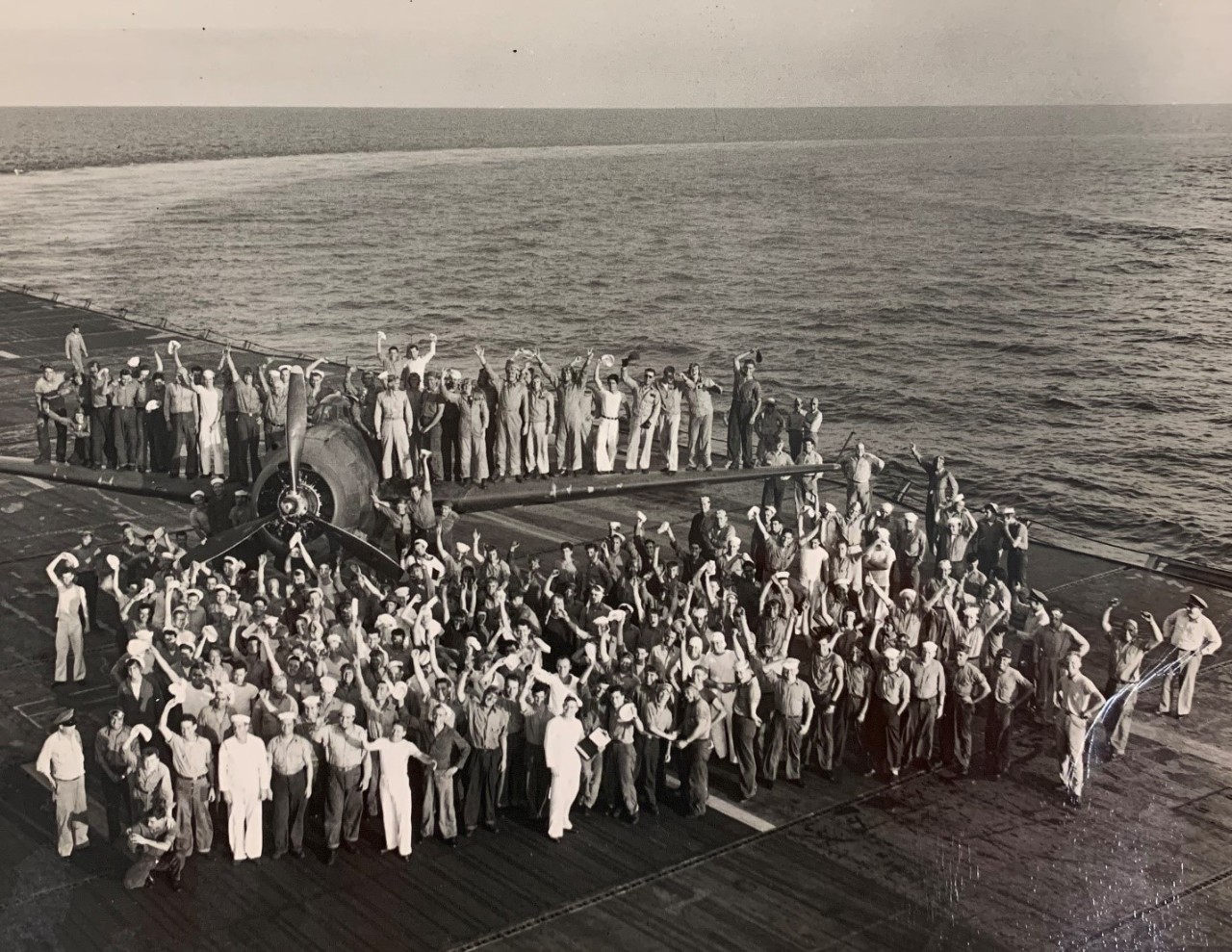
Photograph crew on the USS Sable (IX-81) on Lake Michigan, circa 1943.
The USS Sable (IX-81) was one of two ships making up the “Corn Belt Fleet” on Lake Michigan. The ship was originally a passenger steamer refitted to be a training aircraft carrier during World War II. The flight deck on the USS Sable was shorter than the deck of a typical aircraft carrier. If a pilot learned to land on the short deck, he should be able to land on the longer decks out at sea.
Lake Michigan was the perfect location for pilots to learn the skills needed to land on an aircraft carrier; there were no chances of the USS Sable being attacked by a Japanese battleship or a German U-boat.
This photograph was donated to the permanent collection by Commander Harry Hadsell Crow, executive officer of the USS Sable (IX-81).
November 2020
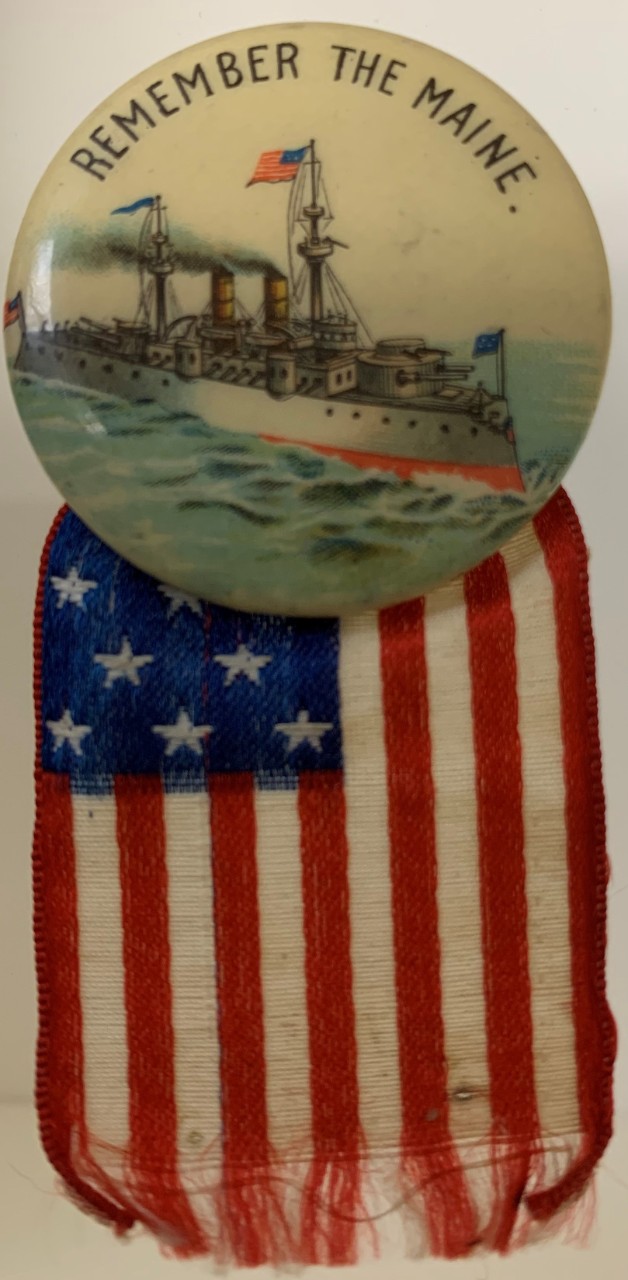
"Remember the Maine" Pin
At an estimated age of about 122 years old, this artifact is new to the National Museum of the American Sailors’ permanent collection. It is a small brightly colored pin-back; on the front it reads, “Remember the Maine” under this statement is a color image of the battleship USS Maine steaming through blue waters. This small image is attached to the metal backing and the front is sealed with celluloid, which creates a shiny durable surface. Fastened at the button of this pin is a small silk American Flag. This pin-back was created in remembrance of the sinking of the battleship USS Maine on 15 February 1898. The battleship had been anchored in the Havana Harbor when at 9:40pm an explosion rocked the USS Maine; two hundred and sixty men lost their lives that night and an addition six in the following days.
This pin-back was created by the Whitehead & Hoag Company which was founded by Benjamin S. Whitehead and Chester R. Hoag in Newark, N.J. in 1892. Whitehead & Hoag made a variety of products including flags, banners badges and lapel buttons. The buttons or pin-backs ranged from political and commemorative to general souvenirs and where an easy low-cost way to advertise. During both World War I and World War II the company also made several items for the United States Navy including photo badges and identification pins.
This artifact was kindly donated by the National Museum of the American Sailor Foundation (NMASF). Please visit the National Museum of the American Sailor Foundation's website for more information.
December 2020
Postcard of the Library at Naval Station Great Lakes
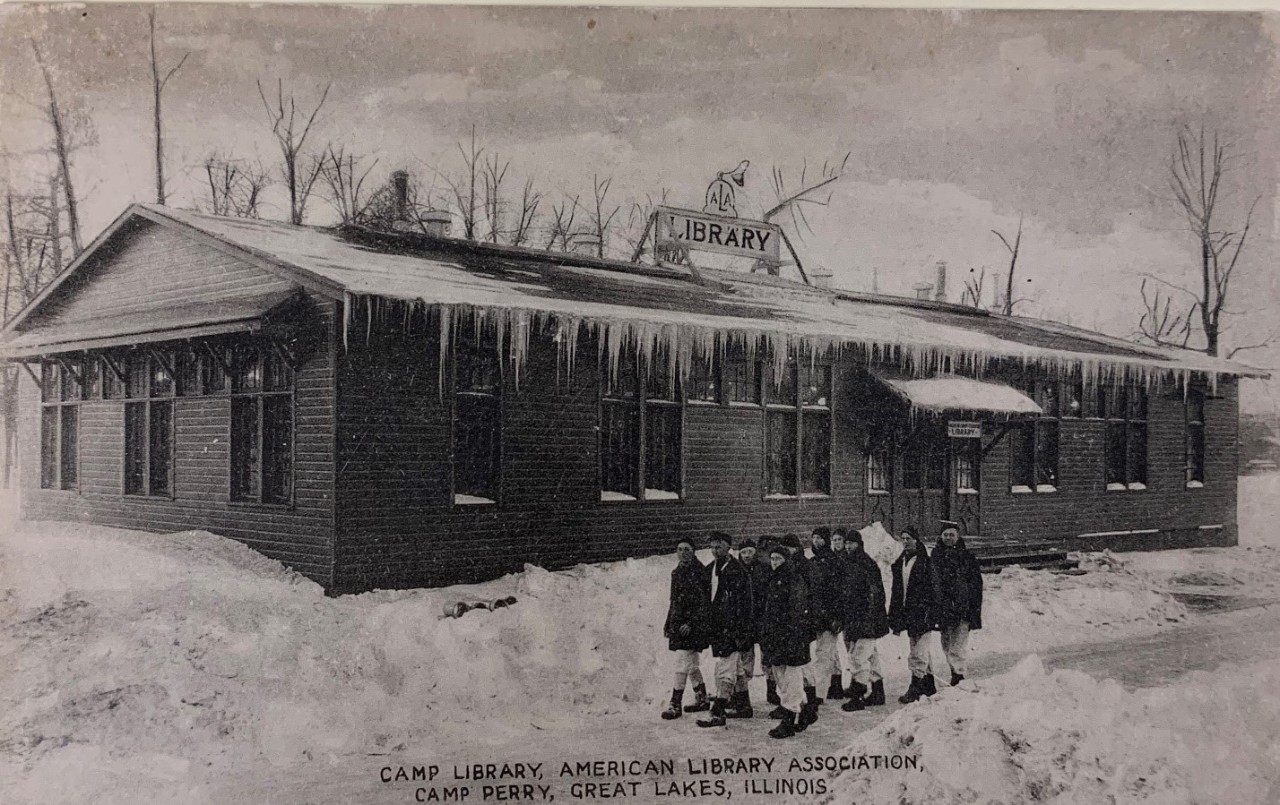
While Sailors are busy learning how to serve the United States Navy, they often miss their friends and family back home and want to connect. Sailors today send emails, but for most of Naval Station Great Lakes’ history, sailors sent home physical mail. Often in the form of a letter or a postcard - like the one shown here. Sailors could purchase postcards (often with images of various locations on base) and send a quick note home letting everyone know how they were doing. This postcard, donated by Stuart Nishimoto, depicts a former library on base. Today, there is still a library for sailors and their families to use at Naval Station Great Lakes.



